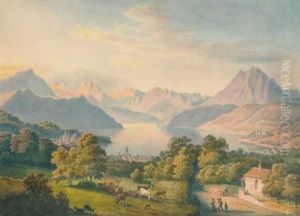Leonhard Diefenbach Paintings
Leonhard Diefenbach was a German painter and illustrator, born in 1814 in Hadamar, then part of the Duchy of Nassau. He is often associated with the Nazarene movement, a group of early 19th-century German Romantic painters who aimed to revive honesty and spirituality in Christian art. This movement was characterized by its devotion to historical accuracy in the depiction of biblical and medieval subjects, as well as an emphasis on nature and the detailed study of Italian art from the Renaissance and Early Christian periods.
Diefenbach's work reflects the influence of the Nazarenes, particularly in his focus on religious themes and use of clear lines and vivid detail to convey moral and spiritual messages. He studied art in Frankfurt and Munich, where he was likely exposed to the works of other Nazarene artists, such as Peter von Cornelius and Friedrich Overbeck, who were key figures in the movement. Diefenbach's commitment to religious subjects and his meticulous style were in line with the Nazarenes' rejection of the academic standards of their time, which they saw as corrupt and lacking in genuine spiritual values.
Throughout his career, Diefenbach produced a body of work that included altarpieces, frescoes, and illustrations for books. His paintings often feature biblical scenes, saints, and figures from Christian tradition, rendered with an attention to detail and a clarity of form that highlight his technical skill and his dedication to his Nazarene ideals. Despite his association with the Nazarene movement, Diefenbach's work also shows a personal interpretation of his subjects, with an emphasis on emotion and the human experience of the divine.
Leonhard Diefenbach died in 1875, leaving behind a legacy that contributes to our understanding of the Nazarene movement and its impact on 19th-century German art. His work is preserved in various collections and continues to be studied for its artistic and religious significance.
